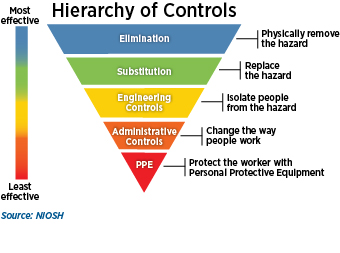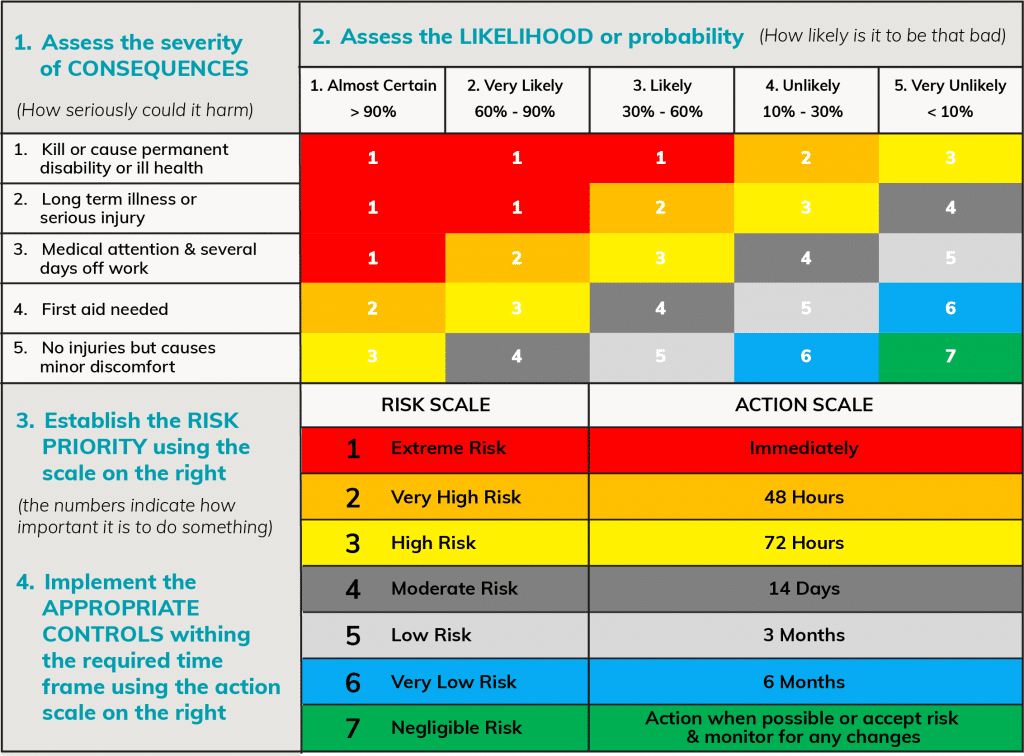Which Term Describes the Elimination of a Hazard
Many of the concepts of inherently safer design have been applied by engineers in a wide variety of technologies for many years without recognizing the common approach. The control of physical condition is basic and frequently difficult in a plant and it requires the best of scientific engineering and management information for its accomplishment.

Identifying The 6 Types Of Hazards In The Workplace Safetyculture
Purchasing insurance is an example of risk.

. The elimination of hazards is the first order of safety. Minimize or eliminate safety and health risks. The top level of the hierarchy is elimination which is when a hazard is completely taken out of the workplace.
As the number of insured units increases the number of losses decreases. And help employers provide workers with safe and healthful working conditions. Includes designs or modifications to plants equipment ventilation systems and processes that reduce the source of exposure.
Start studying Chapter 2 Nature of Insurance. Learn vocabulary terms and more with flashcards games and other study tools. Substitution engineering control administrative control or PPE.
Which term describes the elimination of a hazard. The hierarchy of control is a step-by-step approach to eliminating or reducing risks and it ranks risk controls from the highest level of protection and reliability through to the lowest and least reliable protection. Effective controls protect workers from workplace hazards.
As the result there will be no remaining hazard after implementing this method. Help avoid injuries illnesses and incidents. Substitution involves replacing the risk hazard or method with a different one which.
Well-designed engineering controls can be highly effective in protecting workers and will typically be independent of. One way insurers deal with catastrophic loss is through reinsurance b. For example if a workstation causes ergonomic.
With the elimination method hazards are removed completely from their sources. The CSA Z1002 Standard Occupational health and safety - Hazard identification and elimination and risk assessment and control uses the following terms. Harm physical injury or damage to health.
As the number of units increases the number of losses decreases. Eliminating the hazard and risk is the highest level of control in the hierarchy followed by reducing the risk through substitution isolation and engineering controls then. The evaluation and control of mechanical and physical hazards encompass four engineering aspects.
The pyramid of hazard controls emphasizes eliminating hazards at the source. Health care costs can be better controlled by utilizing preadmission testing. Basically a hazard is the potential for harm or an adverse effect for example to people as health effects to.
The processes described in this section will help employers prevent and control hazards identified in the previous section. Engineering controls are favored over administrative and personal protective equipment PPE for controlling existing worker exposures in the workplace because they are designed to remove the hazard at the source before it comes in contact with the worker. Risk pooling risk avoidance Which of these statements regarding insurance is false.
Elimination - The first and the best way to eliminate the hazard is by removing the initial element or cause machine or the process all together. In most cases elimination is not feasible and when possible substitution is the best approach to hazard mitigation. Hazard a potential source of harm to a worker.
When possible substitute less hazardous agents in place of their more hazardous counterparts. Elimination is the most effective of the five members of the hierarchy of hazard controls in protecting workers and where possible should be implemented before all other control methods. Preadmission testing can reduce the.
Hazard control with the elimination method is the most effective method compared with other hazard control methods. The most preferred method of controlling risk is to eliminate the hazard altogether. Hazard Prevention and Control.
Remove the hazard from the workplace or substitute replace hazardous materials or machines with less hazardous ones. Which term describes the elimination of a hazard. Elimination including substitution.
Substitution - Substitution is the second best option when it comes to the hierarchy of risk control. Which of these statements regarding insurance is false. How can an insurance company minimize exposure to loss.
Elimination - Eliminating the risk completely is the best control possible because then the hazard does not exist anymore and can not cause any harm. Inherently safer design is a philosophy which focuses on elimination of hazards or reduction of the magnitude of hazards rather than the control of hazards. Substitution - Substitute with an alternative non-hazardous or less hazardous material machine or process.
Many jurisdictions require that an employer eliminate hazards if it is. Rates can be calculated to compensate for losses is an example of the law of large numbers. Hazard elimination is a hazard control strategy based on completely removing a material or process causing a hazard.
A hierarchy of hazard control can be briefly described as follows. Which term describes the elimination of a hazard. Enclosure of the hazard using enclosed cabs enclosures for noisy equipment or other methods.
Employers should begin at the top of the pyramid and work their way down when trying to reduce hazards. Eliminationminimization of the hazard -- Designing the facility equipment or process to remove the hazard or substituting processes equipment or materials to reduce the hazard.

Hazard Identification Risk Assesment And Risk Control Hirarc

Safety Management Hazard Prevention And Control Occupational Safety And Health Administration

What Is The Difference Between Hazard And Risk The Safety Wellbeing Rehab Experts
Comments
Post a Comment